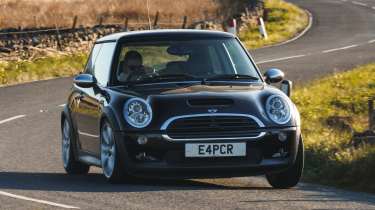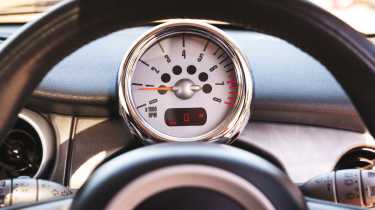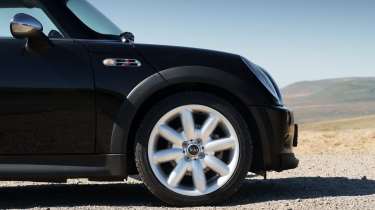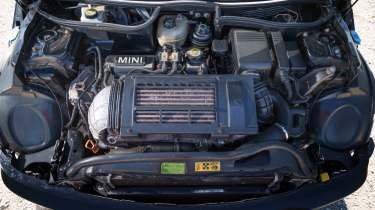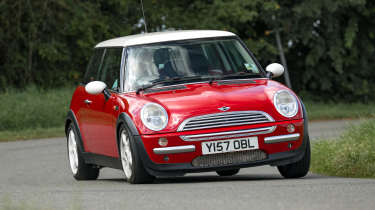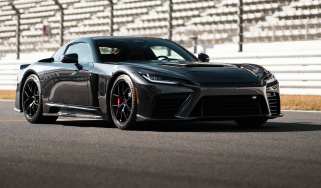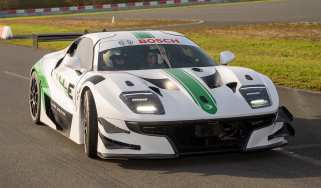Mini Cooper and Cooper S (2001 - 2006) review – the 'new' Mini is now a classic
The ‘new’ Mini was perhaps motoring’s most anticipated sequel. BMW didn’t get it wrong – quite the opposite, as it transpired
Perhaps the most significant mainstream car of the new millennium, the ‘New’ Mini as it was called, proved the power of premium to the world. It reinvented one of the ultimate people’s cars into an item of desire. Here was a hatchback inspired by one of the great motoring levelers, that people lusted after, that they bought with their heart over their head, and in their droves too.
New custodians BMW (having divorced from Rover and taken custody of the Mini brand in the process) were canny in their approach, first establishing that aspirational brief for the car, then making resources available to get the job done.
The original ‘New’ Mini wasn’t the first retro-inspired car. Volkswagen had already reimagined the Beetle but it wasn’t wildly successful, perhaps because it was cartoonish rather than a cool take on the classic. It was as fun to drive as it was to look at, too – essential to the authenticity of what had to be one of the most anticipated motoring sequels. A Mini was a sure-fire shoo in for our evo Eras: the 2000s test.
History
The launch of the original BMW Mini Cooper was a very different affair to your regular German event. The conference room was more like a nightclub, a heavily Mini-themed space, bold and black as the showrooms would be, and populated by tie-less executives.
More reviews
In-depth reviews
Reviews
The car we would soon drive on the roads near Perugia in Umbria, Italy, was even more surprising. As its designer Frank Stephenson later said, the Germans were terrified that they’d mess up and kill a British icon. They didn’t, they knocked it out of the park. The Mini looked dynamic and an evolution of the original; you could imagine there being a couple of earlier models, design stepping stones leading to the R50, as the new Mini was known internally.
Its design was refreshingly new yet reassuringly familiar, self-confident and fun. ‘Well, well, well… They’ve done bloody well, I’ll give them due credit for that. Everybody’s tried it and haven’t got anywhere near it…’ was the reaction of Jack Daniels, Alec Issigonis’s right-hand man, in the company of our columnist Russel Bulgin when accompanying for a preview of the new car at the time. It was bejewelled with bespoke details, like the chrome-rimmed lights front and rear, and the large, central speedo and row of rally car-style toggle switches, another nod to the original. Its wide-track, wheel-at-each-corner stance promised keen dynamics.
Production was delayed slightly by BMW’s disposal of Rover Group (which apparently got to keep the Mini development costs in the divorce). History shows that BMW was bang on the money insisting that the new Mini be a fun-to-drive, upmarket car rather than the utilitarian replacement for the Metro/Rover 100 that the Brits had wanted. Meanwhile, the trim packs offered – Salt, Pepper and ‘Chili’ – were just the start of personalisation options that would add greatly to both the Mini’s appeal and BMW’s profits and prompt imitations from other car makers.
The supercharged Cooper S arrived in short order as a proper hopped-up hot hatch, further iterated on in the John Cooper Works and JCW GP, while Cabriolet variants doubled down on the Mini’s chique appeal. The first ‘new’ Mini was timeless from the word go and could have stayed on sale with minimal updates to an adoring market for many years beyond its 2006 conclusion.
At launch, the price for the Cooper was a wow – just £11,600, which looked amazing value for money. And it was, unless you were tempted by the options, which we at evo were. We pulled a few strings to get an early car (Y362 MGM) and found ourselves with a long-termer that cost almost £15k. It was an experience that would be repeated in Mini showrooms the world over.
Ironic then that in August 2004 we ran a news story declaring ‘BMW says Mini costs too much to make!’ You could only admire the commitment of the Germans in replicating another feature of the original Mini. No tears needed to be shed for BMW, though, because profits would soon balloon thanks to an ever-expanding range of options that allowed buyers to personalise their Minis, a business model that others would soon attempt to emulate.
Engine, gearbox and technical highlights
It was underpinned by a technically sophisticated chassis: up front it had MacPherson struts like its supermini rivals but at the rear it had a version of the BMW multi-link Z-axle when most rivals had a twist beam or something similarly simple. And yet the Cooper was priced £200 less than its keenest rival, the Peugeot 106 GTi.
Under the clamshell bonnet was the joint venture Tritec or Pentagon 1.6-litre ‘four’. This clean-sheet design, developed in conjunction with Chrysler, was an iron-block, single-cam, 16-valve engine built in Brazil. It appeared to offer nothing over the all-aluminium, twin-cam K-series that was built next door to the Mini factory and had already paid back its development costs… except that it fitted under the bonnet.
In some markets there was a 1.4-litre Tritec for the Mini One, but in the UK it was the same 1.6 as in the Cooper but fitted with a different ECU that simply restricted the throttle opening to cap power at 90bhp. For a few hundred quid you could get an aftermarket chip that gave full throttle and better-than-Cooper power.
Bolting on a Roots-type supercharger to to the Tritec boosted power from 113 to 168bhp and gave it some life. The S also got a six-speed ’box, better seats and 16-inch alloys, and, oddly enough for those familiar with hot Minis of old, the blower brought a facsimile of the straight-cut gear whine that often characterised them.
Driving the Mini Cooper and Cooper S
‘It’s been many years since I’ve sat in an original BMW Mini, and the cockpit that was so amazing back then isn’t quite so stunning now. Not because it’s a bit worn in places but because Mini cockpits, particularly their facias, have only got more dramatic, the central dial growing from the size of a saucer to the size of a dinner plate. Interior space wasn’t the major objective that it was in the classic Mini with its external body seams, but while it’s cramped in the rear of an R50 it’s roomy up front and the driving position is excellent, with steering wheel, seat and pedals all aligned – not always the case in small cars.
‘Two decades on, performance feels a bit thin. I don’t think this car is down on power, it’s just that the near-total roll-out of turbocharging in the intervening years has conditioned us to expect generous, readily available torque. The supercharged Cooper S was just around the corner, of course, and its 163bhp would satisfy the power-hungry and give the chassis a proper workout.
‘The chassis of this car has been well fettled; it’s had new brakes, new dampers and all of the suspension bushes have been replaced with Powerflex items. It feels pretty tight and within a mile it all comes flooding back: the lovely demeanour, the way all the weight feels low-slung like it’s underneath your seat, the solid way the car rides on a good road and how it feels a bit short-travelled on a choppy road but is still compliant so you can keep your toe in.
‘This example is taut and grips well on its 16-inch rims and tyres – a newly acquired set of Falken runflats – but there’s a bit more steering effect, a bit more rotation than you expect. I suspect that the suspension alignment is a little out, maybe at the rear where the camber looks a bit off. Whatever, there’s a bit more response than you’re expecting when you bung it into a turn, not lift-off oversteer in the classic sense, just enough to make you take notice and adjust your inputs accordingly. I quite like it. It feels like how the Mini might have been set up if it had been down to a Peugeot engineer. What I would like is more lateral support from the seats; they’re comfy enough, you just want to be held in place better when you’re bombing around.
‘It’s marvellous to get into a Cooper all these years later and rediscover those traits. The steering wheel is quite big, the response to inputs not especially sharp, but you feel on top of the mass of the car and sort of direct things as it zips around corners. It’s a well-worn cliché but it’s almost like you’re driving a go‑kart. It’s so very biddable that you don’t have to use the brakes, you just chuck it in and scrub off speed when you need to.
‘It’s been great to make the original Cooper’s acquaintance again more than 20 years on and discover that not only does it now feel properly small, but also that it’s still loaded with character and is capable and properly entertaining. The Cooper is a proper evo car and a fully-fledged icon.’ – John Barker, who tested the R50 Mini Cooper in the evo Icon feature in issue 321.
‘This example rides on 17s that are a sort of nod to classic Minilites but look massive, cartoonish almost, on such a small car. It’s just had a brand new set of Continentals and feels frisky and super-grippy. It’s still a proper event to drive, being surrounded by such a bespoke interior.
‘As with the standard Cooper, the chassis of the S has that short-legged feel plus a very direct front end, so it’s super-agile. The delivery is consistent, a little unexciting in that it doesn’t peak, perhaps, but it’s punchy, while the shift is short and has a proper heft to it. I have to say that this example is feeling its age, as Minis of this generation tend to; the damping is a bit loose and the geo could do with a tweak to bring back the steering self-centring, but it’s still great fun to hustle along.’ – John Barker, evo editor-at-large, who drove the R53 Cooper S during our evo Eras: the 2000s test.
‘At low speeds it’s familiar Mini: quick steering, strong torque, stiff, flat ride. Over ragged tarmac, the GP shows some subtle differences. It’s still firm but somehow it feels more rounded, less likely to skip over sharp ridges and bounce the car off line. Sounds great, too. The 1.6-litre supercharged engine revs with all the intensity of a little screamer, but the strong torque means you don’t have to stir the sweet-shifting six-speed ‘box to make quick progress.
‘There’s a bit more roll than I’d expected, but that allows the 205/40 Dunlops’ treadblocks to lock into the surface and hook the nose into the apex. Jump on the power as you feel it settle and the standard limited-slip diff transmits all 218bhp to the road with immense composure, steering wheel gently writhing in your hands.’ – Jethro Bovingdon, evo contributor, who tested the Mini Cooper S Works GP in evo 094
Mini Cooper and Cooper S values and buying guide
The original ‘new’ Mini isn’t so new anymore and as exotic and stylish as it still feels today, it was a ‘normal’ car, in that people bought them to use and put miles on every day. So clean, low-miles examples are rare things and carry a real premium.
The leggier cars will be showing signs of their age and use, being prone to rust on the bodywork around the fuel filler and rear subframe. All these early Minis are fun, planted cars to drive, with a stiff ride the compromise. Less compliance means the car’s chassis has been worked harder over the years, so you’re going to want to listen for suspension knocks and squeaks that could suggest bushings, dampers, top mounts or springs are in need of a refresh.
The engines tend to use a little oil so a sturdy record of servicing is desirable for proof your chosen example has been taken care of. Load up the throttle on the clutch with the bonnet open when inspecting the car, as excess rocking from the engine could indicate the hydraulic engine mounts are tired. The supercharged Cooper S has a habit of running hot and the blower itself is known to need a refresh at 100k-mile intervals.
Early Mini Coopers with low miles in really good condition are worth upwards of £6k. Leggier, slightly more tired cars that could be easily ‘saved’ are worth upwards of £4k. Want a project car or one that’s bang average? Budget £1k-£3k. That was what you’d pay for an average Cooper S a decade ago. Now? A project car is upwards of £1500, decent ones are c/£5k, good ones over £6k and tiny miles minters are over £12k. The GP is a sure-fire modern classic, with most worth upwards of £16k.
Specs
| Cooper | Cooper S | Cooper S Works GP | |
| Engine | 1598cc, in-line 4cyl | 1598cc, in-line 4cyl, supercharged | 1598cc, in-line 4cyl, supercharged |
| Max power | 113bhp @ 6000rpm | 168bhp @ 6000rpm | 215bhp @ 7100rpm |
| Max torque | 110lb ft @ 4500rpm | 155bhp @ 4000rpm | 184lb ft @ 4600rpm |
| Weight | 1050kg | 1140kg | 1090kg |
| Power-to-weight | 109bhp/ton | 143bhp/ton | 200bhp/ton |
| 0-62mph | 9.2sec (claimed) | 7.2sec (claimed) | 6.5sec (claimed) |
| Top speed | 124mph (claimed) | 135mph (claimed) | 149mph (claimed) |
